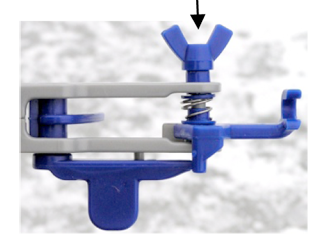
Things To Remember When Using The Jaw Jacker
1. Keep water from getting in the trigger.
When you hook a fish and grab the rod from the Jawjacker, be sure to move the Jawjacker a couple feet from the hole. Water from a splashing fish can get in the trigger mechanism and freeze it up. Winshield de-icer can be bought from your local auto parts store or wallmart for 3 or 4 dollars a can and works great for accidental freeze ups.
2. You can adjust the trigger tension.
You can adjust the trigger tension from super light to heavy by screwing the wing nut in and out on the side of the trigger. We recommend usually always keeping the trigger tension on the lightest setting possible, but there are some times when you will need to increase the tension. When using heavier lures increase the trigger tension so that the weight of the bait won’t set the jawjacker off. If you are using live minnows for bait adjust the trigger so that the minnow can’t pull hard enough to set the Jawjacker off but a biting fish can. You might encounter other situations other than these where you need to adjust your trigger tension. Use this feature to adapt to your fishing situation.

3. Be careful around the Jawjacker.
You and others with you should always keep yourselves clear from the path the rod travels while setting the Jawjacker and while the Jawjacker is set. Adult supervision is always required. Misuse or careless use may cause serious injury, particularly to the eye. Fishing rods used with the Jawjacker can be dangerous if you are in their direct line of travel.
4. Jawjackers work with most ice fishing rods.
Match your rod and adjust the Jawjackers settings to fit your fishing situation. Your rod needs to be stiff enough to adequately set the hook but not so stiff that it breaks your line or straitens out your hook on the hook set. You can also adjust your rod angle with the rod holder pin to help control how hard or soft your rod sets the hook. Stiffer rods set the hook best. Rods up to 30 inches are ideal for the JawJacker. Ice rods 32- 36 inches will also fit except for extremely stiff pike and lake trout rods. Jason Mitchell lake trout rods up to 36 in. work well in the JawJacker.
5. Using live minnows for bait.
If you want to use live minnows with the Jawjacker I would recommend using a single hook or jig head with small to medium sized minnows and a bait harness with larger minnows. With the bait harness put one hook through the nose and one through the lower back. You want to make sure that when a fish hits the minnow or small fish, it grabs a hook too, otherwise you won’t hook the fish. Also adjust the trigger tension with the wing nut on the side of the trigger so that the minnow can’t pull hard enough to set off the Jawjacker but a biting fish can.
6. The Jawjacker is designed not to harm your fishing line.
Any area that contacts or could contact the fishing line is smooth, like the guides on your rod, so that if the line touches the Jawjacker while a fish is on it shouldn’t damage your fishing line. It is still a good idea to move the Jawjacker a couple of feet off the hole just to make sure you have a clear hole to fight the fish through and also to make sure water from a splashing fish doesn’t get in the trigger mechanism and freeze it up.
7. The Jawjacker is legal in most states and some provinces.
The JawJacker is legal in your state or province as long you don’t live in Minnesota. In some states the JawJacker falls into their the tip-up category and other states it is counts as a single line. Call your local DNR office to be sure of how many JawJackers you can use at one time if your ice fishing regulations aren’t clear on the matter.
